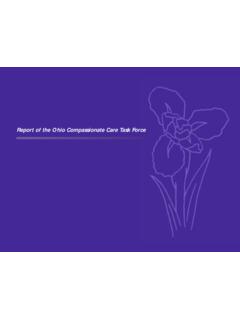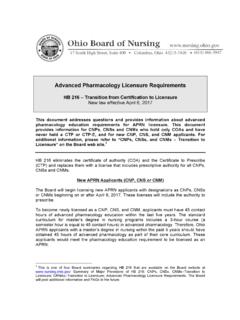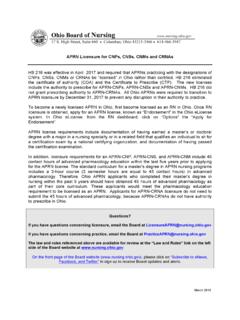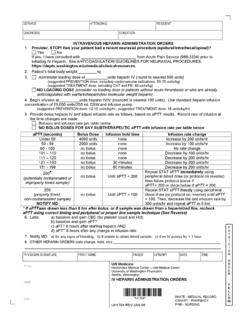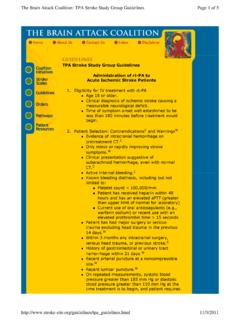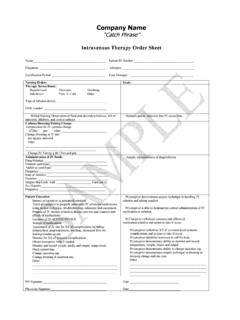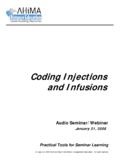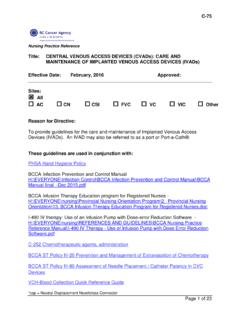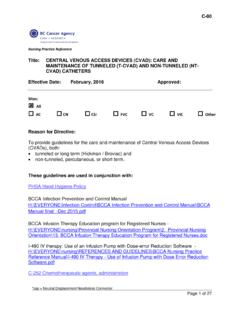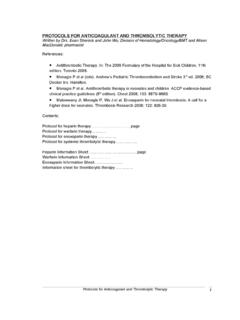Transcription of Scopes of Practice: Registered Nurses (RNs) and Licensed ...
1 1 Scopes of Practice: Registered Nurse and Licensed Practical Nurse Introduction The purpose of this publication is to assist in identifying and differentiating between the Scopes of practice of the Registered nurse (RN) and the Licensed practical nurse (LPN). This is not an all-inclusive list and summary. Board of Nursing licensees have a responsibility to review and apply Chapter 4723 of the Ohio Revised Code (ORC) and the administrative rules adopted thereunder when engaged in nursing practice. The Nurse Practice Act and the administrative rules can be reviewed and downloaded from the Board s website: in the law and rules link.
2 This publication does not announce a new policy but is intended to provide guidance to licensees regarding existing law and rules. Scopes of Practice The Scopes of practices for the RN and the LPN are set forth in Section , ORC. Practice as a Registered Nurse. Section (B), ORC, defines the scope of Registered nurse practice as: Providing to individuals and groups nursing care requiring specialized knowledge, judgment, and skill derived from the principles of biological, physical, behavioral, social, and nursing sciences. Such nursing care includes: (1) Identifying patterns of human responses to actual or potential health problems amenable to a nursing regimen; (2) Executing a nursing regimen through the selection, performance, management, and evaluation of nursing actions; (3) Assessing health status for the purpose of providing nursing care; (4) Providing health counseling and health teaching; (5) Administering medications, treatments, and executing regimens authorized by an individual who is authorized to practice in this state and is acting within the course of the individual s professional practice.
3 (6) Teaching, administering, supervising, delegating, and evaluating nursing practice. 2 Practice as a Licensed Practical Nurse. Section (F), ORC, defines the scope of practical nursing as: Providing to individuals and groups nursing care requiring the application of basic knowledge of the biological, physical, behavioral, social, and nursing sciences at the direction of a Licensed physician, dentist, podiatrist, optometrist, chiropractor, or Registered nurse. Such nursing care includes: (1) Observation, patient teaching, and care in a diversity of health care settings; (2) Contributions to the planning, implementation, and evaluation of nursing; (3) Administration of medications and treatments authorized by an individual who is authorized to practice in this state and is acting within the course of the individual s professional practice, except that administration of intravenous therapy shall be performed only in accordance with section or of the Revised Code.
4 Medications may be administered by a Licensed practical nurse upon proof of completion of a course in medication administration approved by the board of nursing. (4) Administration to an adult of intravenous therapy authorized by an individual who is authorized to practice in this state and is acting within the course of the individual s professional practice, on the condition that the Licensed practical nurse is authorized under section or of the Revised Code to perform intravenous therapy and performs intravenous therapy only in accordance with those sections; (5) Delegation of nursing tasks as directed by a Registered nurse; (6) Teaching nursing tasks to Licensed practical Nurses and individuals to whom the Licensed practical nurse is authorized to delegate nursing tasks as directed by a Registered nurse.
5 Chapter 4723-4 Ohio Administrative Code (OAC) requires the RN and LPN to maintain current knowledge of the duties, responsibilities and accountabilities for practicing within their respective Scopes of practice and for safe nursing practice. Similarities and Differences Registered Nurse. The RN is authorized to engage in all aspects of nursing practice. It is the RN who determines the data to be collected to determine the patient s health status. This is assessing the patient s health status as identified in Section (B)(3), ORC. Assessing health status is further defined in Section (D), ORC, as the collection of data through nursing assessment techniques, which may include interviews, observation, and physical evaluations for the purpose of providing nursing care.
6 Based on this health status assessment the RN determines the nursing care that should be provided to the patient in accordance with Section (B)(2), ORC. Nursing regimen is also 3 further defined in Section (C), ORC, in that it may include preventative, restorative, and health-promotion activities. The definition of patient is set forth in Rule 4723-4-01(A)(4), OAC. Patient means the recipient of nursing care, which may include an individual, a group, or a community. Therefore, the nursing regimen prepared and implemented is not limited to individual patients, but may be established for specific populations or defined groups. Rule 4723-4-03, OAC, provides further detail concerning the implementation of the nursing regimen and the standards of RN practice.
7 Licensed Practical Nurse. The LPN has a dependent role and may provide nursing care only at the direction of a Registered nurse, physician, dentist, podiatrist, optometrist or chiropractor (Section (F), ORC). The direction required for LPN practice is further defined as communicating a plan of care to a Licensed practical nurse (Rule 4723-4-01(B)(6), OAC). This Rule further explains that the direction provided by an RN to an LPN concerning nursing practice is not meant to imply the [RN] is supervising the [LPN] in the employment context. A physician, dentist, podiatrist, optometrist or chiropractor, or the RN may provide to an LPN verbal or written direction of the plan that each of these health care providers have established for the patient.
8 The LPN is then authorized to execute the plan in accordance with the standards in Rule 4723-4-04, OAC. When the RN communicates the plan of care to the LPN, it may be verbally, in the form of an established nursing plan of care, or both. An LPN is accountable to readily identify the RN or other authorized health care provider that is directing the LPN s practice. Otherwise, the LPN may be engaging in practice beyond the LPN authorized scope. Supervision of Nursing Practice. The supervision of nursing practice is contained within the definition of RN practice, noting that RNs teach, administer, supervise, delegate, and evaluate nursing practice (Section (B)(6), ORC). LPNs are authorized to delegate nursing practice when directed to do so by a RN.
9 It is the practice of nursing that the RN supervises and evaluates, rather than a person s employment performance. The supervision and evaluation of nursing practice is further addressed in Rule 4723-4-06, OAC. Supervision of employee performance and other employment requirements are established by the employer and may encompass responsibilities beyond the Licensed practice of nursing. For example, the supervision of nursing practice may include a determination by the RN that a particular nursing intervention is no longer appropriate for a patient and that the nursing regimen should be changed in response to the patient s needs.
10 The RN may base this change on information communicated by the LPN and the RN may further direct the LPN to implement the revised nursing regimen, or the RN may implement the revision him/herself. The RN must minimally be continuously available to the LPN, but is not required to be on site on a routine basis to supervise the LPN in all of the nursing practice activities performed by the LPN. The exception is when on-site supervision is explicitly required by nursing law and rule, or is determined necessary by the directing RN. For example, on-site supervision is required in certain environments in which a qualified LPN may perform IV therapy (Section , ORC).
![Verification Info-website 2[1] - Ohio Board of …](/cache/preview/8/1/0/b/7/6/8/6/thumb-810b76862420de8f4f0538bf3550c1da.jpg)




